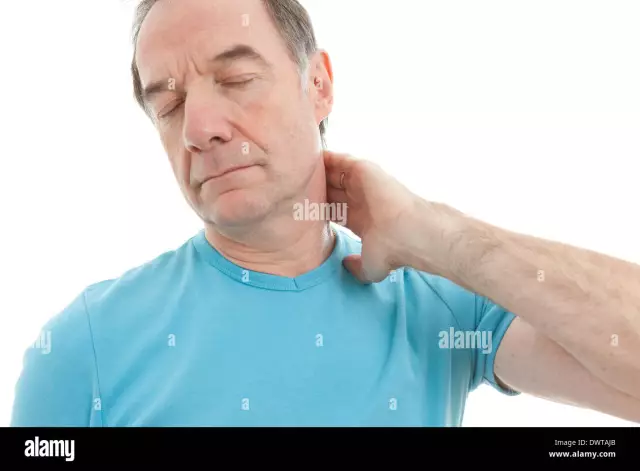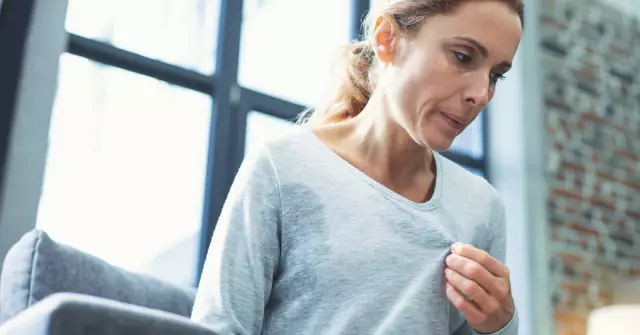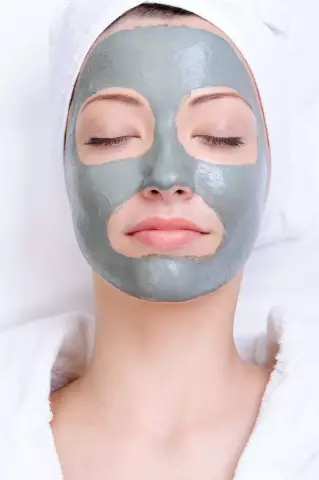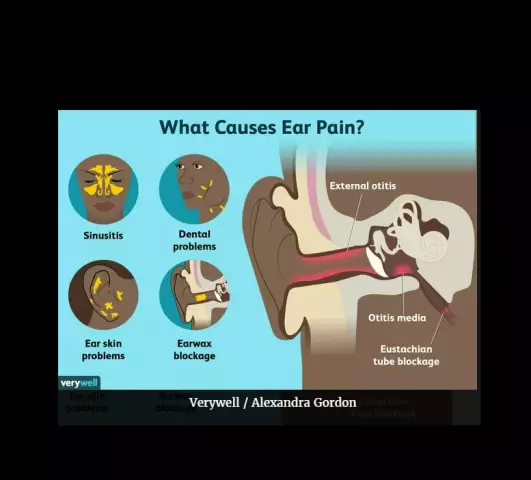- Author Rachel Wainwright [email protected].
- Public 2023-12-15 07:39.
- Last modified 2025-11-02 20:14.
How to deal with neck and nape pain

Pain in the upper neck and back of the head can occur for a variety of reasons. Sometimes it is even difficult to understand exactly where the source of unpleasant sensations is located, since the neck and back of the head hurt at the same time. Pain can often be combined and transferred from one area to another. Its character also differs: constant or arising when the head is turned or touched to it. To get rid of discomfort, you need to know what exactly is causing it.
Neck and nape hurts: causes
If a person often has pain in the neck and back of the head, there may be many reasons for this:
- Diseases of the cervical spine - osteochondrosis, sprains, spondylitis can cause pain in the back of the head, which increases with nodding, turning and other head movements. In this case, massage can help;
- Arterial hypertension is one of the most common causes of pain in the back of the head, especially in the morning;
- Increased intracranial pressure - accompanied by incessant headaches (which become more frequent in the morning and at night), vomiting and nausea. This condition develops due to an increase in the volume of cerebrospinal fluid - the fluid that washes the brain and provides its protection;
- Stress is another common cause of discomfort in the back of the head. Various kinds of mental stress can develop into severe headache. Women over 30 are especially susceptible to this;
- Occupational diseases - the neck and back of the head can be very sore due to a long stay in one uncomfortable position under unfavorable working conditions. This usually happens to drivers and office workers. You can cope with such a problem by regularly doing gymnastics and maintaining correct posture;
- Deformation and growth of osteophytes - degeneration of the ligament tissues, which turn into bone tissue and cause severe pain in the back of the head, radiating to the shoulder girdle. This disease is called cervical spondylosis and most often affects older people who are inactive. At the same time, a person constantly feels discomfort, even at rest. To alleviate the condition, medical help is needed;
- Myogelosis - muscle leakage, can occur due to a draft, a long stay in an uncomfortable position (for example, in a dream), posture disorders. If the neck and back of the head hurt due to myogelosis, the discomfort will go away after a while by itself, but neck massage can improve the condition;
- Neuralgia of the occipital nerve - this disease is accompanied by bouts of acute pain that spreads from the back of the head to the ears and neck when sneezing, coughing, and sudden head movements. At rest, a person experiences pressing, aching pain. Massage can alleviate the condition, but it will only have a temporary effect, the help of a specialist is needed;
- Cervical migraine - in addition to intense pain in the temples and the back of the head, the symptoms of this disease are pain in the eyes and blurred vision. Be sure to see a doctor;
- Prolonged muscle tension - with prolonged muscle tension due to improper position of the neck and head during exercise, working at the computer, reading or other activities, the neck and back of the head can be very sore, with the transition to the frontal part of the head. Another symptom of this condition is an increase in blood pressure.
Neck and nape hurts: treatment
If the pain is sudden and not permanent, you can take the following steps to relieve it:
- Ventilate the room;
- Massage the neck, shoulders and back of the head;
- Lie down and relax;
- Try to get rid of nervous tension.
In situations where the neck and back of the head often hurt, treatment should take place under the supervision of a doctor. First of all, you need to contact a neurologist, who will prescribe an examination to identify the causes of discomfort.
For this, the following are usually used:
- magnetic resonance research method;
- X-ray examination of the spine;
- CT scan.
A cardiologist and a traumatologist will also help determine what exactly causes pain.
How to relieve pain in the back of the head and neck
There are several guidelines on how to relieve this pain before going to the clinic. To reduce its intensity, you can take an anti-inflammatory agent, for example, "Ibuprofen".
If the neck and back of the head hurt often, you should enrich your diet with healthy omega-3 acids, which are found in fatty fish. They prevent the development of inflammatory processes.
Physiotherapy and massage can be very effective. Thus, electrophoresis increases blood flow to stagnant muscles and increases the outflow of harmful lactic acids. A warming neck and upper back massage can partially or completely eliminate or prevent pain symptoms in the occiput.
If the neck and back of the head hurt due to osteochondrosis, exercise therapy will help alleviate the condition. Usually, along with exercise, the doctor prescribes the intake of vitamins and the use of warming ointments that increase blood flow.

To ease the pain in the back of your head, you can try stretching and relaxing your neck muscles by sitting in a chair with a back without leaning on it. Clasp your head with your hands, while putting your thumbs on your cheekbones, and the rest on the back of your head. Tilting your head back, you need to hold it with your hands, resisting. Hold this position for 5-7 seconds, then relax and lean back in the chair. This exercise can be repeated several times.
The best prevention of cervico-occipital pain is a healthy lifestyle. It is necessary to sleep at least 7-8 hours per knock, preferably on an orthopedic pillow. It is necessary to constantly monitor your posture and choose a high-backed work chair. Regular physical activity and exercise and a special diet are also important. People who often have neck and headache are not advised to eat a lot of chocolate, nuts, smoked meats, bananas and spicy foods. It is advisable to give up bad habits and do not forget about good rest.
YouTube video related to the article:
Found a mistake in the text? Select it and press Ctrl + Enter.






